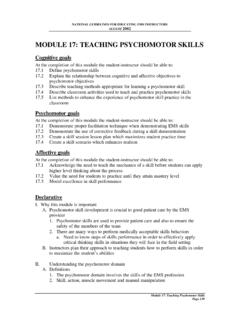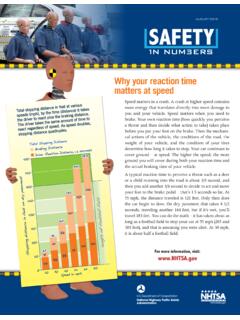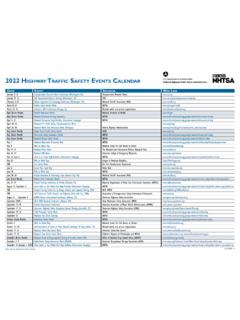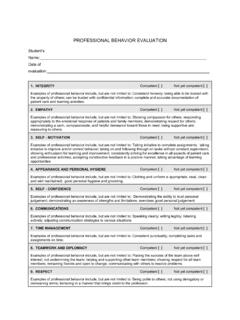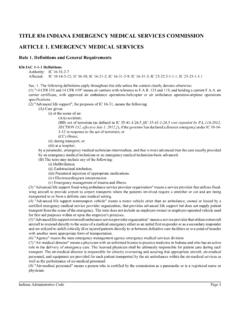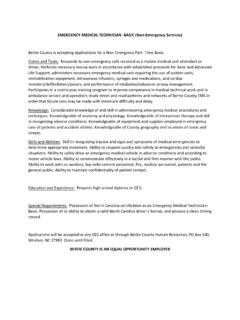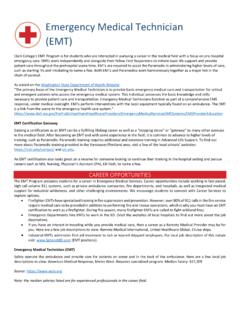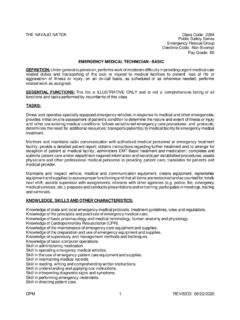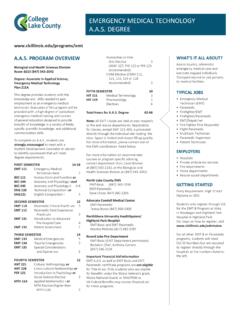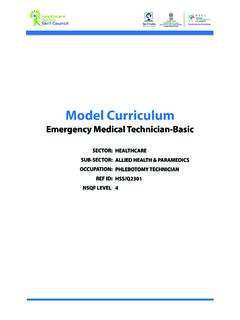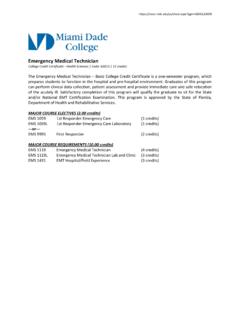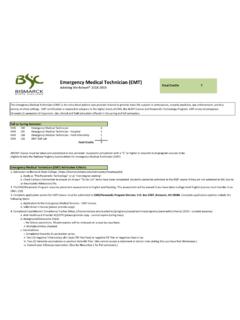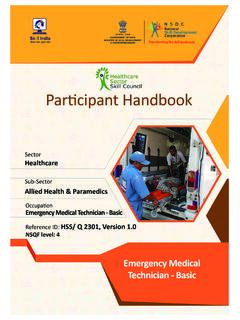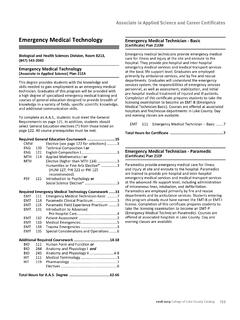Transcription of EMERGENCY MEDICAL TECHNICIAN - BASIC TRAINING …
1 NATIONAL GUIDELINES FOR EDUCATING EMS INSTRUCTORS AUGUST 2002 APPENDIX XVI: EMS Student Handbook Sample EMERGENCY MEDICAL TECHNICIAN - BASIC TRAINING PROGRAM NATIONAL GUIDELINES FOR EDUCATING EMS INSTRUCTORS AUGUST 2002 TABLE OF CONTENTS 1. Mission Statement 3 2. Introduction 4 3. General Information 5 4. Program Responsibilities 7 5. Course Schedule 10 6. Chapter Objectives 13 7. Manipulative Skills 22 8. Appendix 52 NATIONAL GUIDELINES FOR EDUCATING EMS INSTRUCTORS AUGUST 2002 MISSION STATEMENT (Place here) The Mission of the Fire Department is to: Protect the lives and property of the people of our area from fires, natural disasters, and hazardous materials incidents; Save lives by providing EMERGENCY MEDICAL services; Prevent fires through prevention and education programs; and, Provide a work environment that values cultural diversity and is free of harassment and discrimination.
2 NATIONAL GUIDELINES FOR EDUCATING EMS INSTRUCTORS AUGUST 2002 Introduction Welcome to the EMS Academy EMT- BASIC TRAINING Program. On July 1, 1997 the Fire Department assumed the role as the primary EMS provider in this city and county. The EMS Division was created to: Receive all 911 requests for EMERGENCY MEDICAL service; Initiate appropriate response of personnel and response; Treat and stabilize prehospital emergencies; Alleviate pain and suffering of the sick and injured; and, Transport the ill and wounded in a safe and expeditious manner to the appropriate MEDICAL facility. When you complete this program, you will join the 70% of the Fire Department uniform rank that make up the cornerstone of the EMS Division - the EMERGENCY MEDICAL TECHNICIAN - BASIC .
3 Of all of the calls for service the Fire Department handles annually, nearly 80% of them are for MEDICAL assistance. The EMT-B will respond to a large proportion of these calls, will provide the bulk of the initial field care, and will assist the EMT-Paramedic in providing further MEDICAL intervention. As the EMS system evolves it will be likely that the role of the EMT will expand in both scope and responsibility. Therefore it is imperative that you become proficient in your skills and practice of prehospital medicine. The EMS Academy staff will support you in your education and practice; however they will not carry you! You must embrace this course as you would with all other courses at the Fire College. This is an intensive course, and you must avoid falling behind. Please read through these first few pages to determine what will be expected of you.
4 Finally, recognize that being an EMT-B fits in with the role of being a Firefighter: This program will help prepare you for a rewarding, life long profession of providing protection and service to our citizens and visitors. NATIONAL GUIDELINES FOR EDUCATING EMS INSTRUCTORS AUGUST 2002 General Information Location The EMS Academy EMT- BASIC Program is (insert location here.) Hours The EMT- BASIC Program will generally meet on Mondays, beginning May 18, 1998. The hours of the program will be from 0800 to 1730 hours. A mandatory CPR class will be held on Thursday May 14. Lunch will be from 1230 to 1310 hours, unless scheduling mandates a change. In general the classrooms and labs are open Monday through Friday, from 0730 to 1700 hours. Office hours for instructors will be listed.
5 Daily Schedule The daily schedule will generally follow this format: 0700 - 0800 Remediation (makeup period for quizzes, skills) 0800 - 0830 Quiz 0845 - 0900 Pretest 0900 - 1230 Lectures 1230 - 1310 Lunch 1310 - 1700 Skills Lab 1700 - 1730 House chores The program schedule may be found beginning on page 14. This schedule lists the reading assignments and exam schedule for the program. Parking You may park in the lot near the Log Cabin, found near the building. The US Parks Police Department has asked everyone to not park in the front or side of their building. Attendance This is a very intensive course, with large amounts of information and practice scheduled for each session. It is required by the state that each EMT-B student must attend 110 hours of instruction.
6 Therefore it is imperative that you are punctual. Class will begin on time; if you arrive more than 1 minute late you will marked as tardy for that day. If you arrive more than 30 minutes late you will be marked Absent Without Leave - AWOL . You may not miss more than two (2) classes during the didactic (classroom) phase. Being marked absent from more than 2 sessions will result in being dropped from the program. You may not miss ANY sessions during the ride-a-long phase. If you know that you will miss a class for the rare unforeseen EMERGENCY , , Rules for Recruit Members #18 - Injuries , you must contact the primary instructor prior to that class. All hours NATIONAL GUIDELINES FOR EDUCATING EMS INSTRUCTORS AUGUST 2002 missed will need to be made up in the form of essays on the information presented that day.
7 The test or exam must be made up during the remedial hour of the following week. Smoking Smoking is prohibited in the building. Chemical Substance Use If you are seen or suspected of drinking alcohol or using illicit drugs during program hours, you will be immediately suspended from the program, pending investigation. You will be reported to the DOT Captain in charge of Probationary TRAINING . Refer to the Department Policy and Procedure Manual for further information. Discrimination It is the policy of the EMS Academy to provide equal opportunity for TRAINING and education regardless of race, gender, sexual orientation, religion, age or ethnicity. Rules for Recruit Members Other Division of TRAINING Rules for Recruit Members will apply during the EMT- BASIC TRAINING program.
8 Staff and Contact Numbers (Your Program Contact information would be inserted here.) NATIONAL GUIDELINES FOR EDUCATING EMS INSTRUCTORS AUGUST 2002 Program Responsibilities Performance Standards Tests - You must score 75% or better on each test to complete the program. You will be able to remediate tests or exams as necessary. Remediation will be in the form of 1) a review session that identifies your weaknesses, and 2) a remediation test. Each remediation must occur within one (1) week of the original test. The remediation test or exam may not be presented in the same format as the original test. Exams - You must score 75% or better on the midterm and Final exam. The remediation policy is as listed above. If you do not achieve a 75% or better on the remediation quiz or exam, you will be recommended for termination through the Chief of the Department.
9 You may also be recommended for termination if after three (3) original (not remediation) consecutive weekly tests, a score of 100% on the next quiz would be insufficient to attain a 75% average. Skills - You must score a 75% or better on every manipulative skill. If you fail to attain a passing grade on a given skill, you will be scheduled for re-evaluation. If, after two re-evaluations, you fail to attain a passing grade, you will be recommended for termination through the Chief of the Department. You will accrue EMT deficiency points for skill scores below 75%. The schedule is similar to the Fire College schedule: 74% - 72% One (1) EMT deficiency point 71% - 68% Two (2) EMT deficiency points 67% - 64% Three (3) EMT deficiency points 63% - 60% Four (4) EMT deficiency points 59% - below Five (5) EMT deficiency points EMT deficiency points are cumulative throughout the recruit TRAINING period.
10 You will be sent to the Deputy Chief of Administration for a conference when you accumulate a total of ten (10) EMT deficiency points in any combination derived from substandard performance in manipulative skills. If you accrue a total of fifteen (15) EMT deficiency points or more, you will be recommended for termination through the Chief of the Department. Whenever an EMT deficiency point is assigned for substandard performance, a conference with the supervising Captains will be scheduled. Textbook NATIONAL GUIDELINES FOR EDUCATING EMS INSTRUCTORS AUGUST 2002 The Program will be using the eighth edition of EMERGENCY Care, by Brady Publishing. The Department will issue books before class begins. You are encouraged to purchase the book for your own reference. If you do not purchase the book, you must keep it in a neat and presentable condition.



